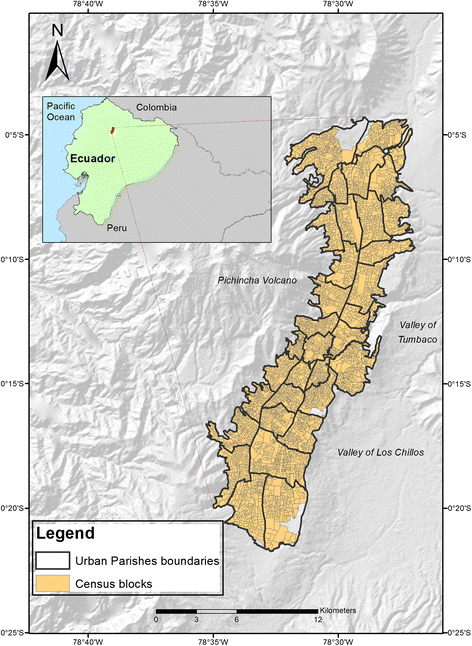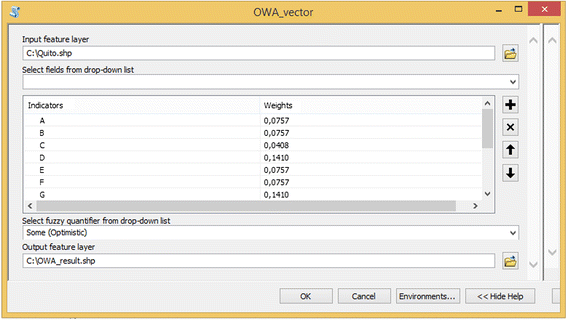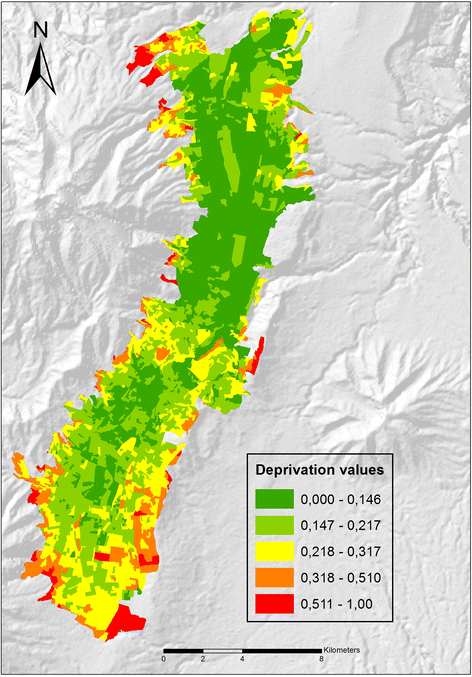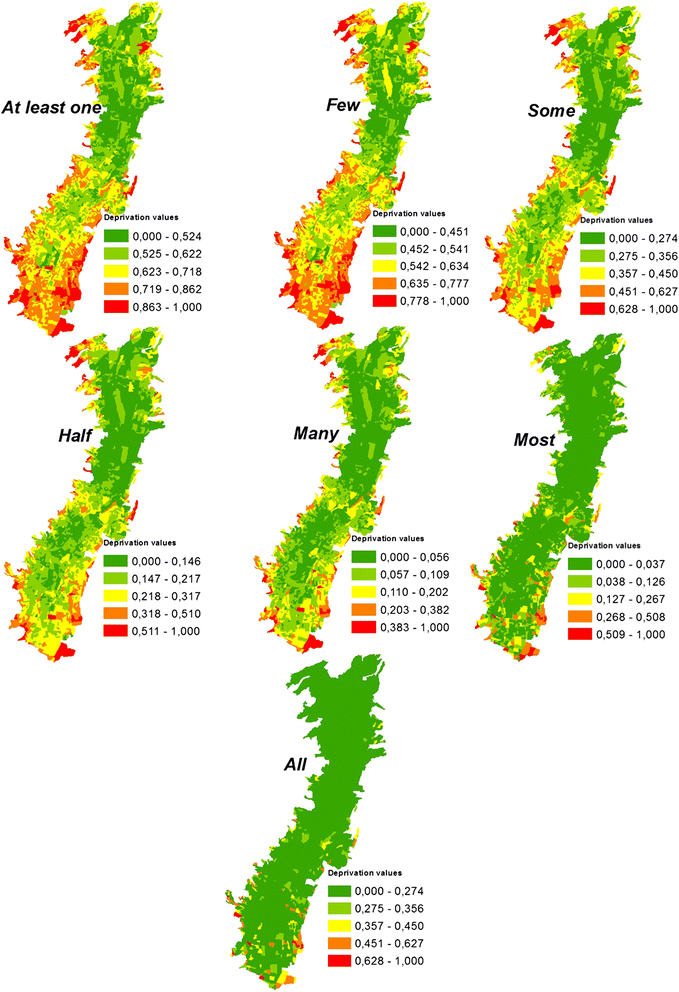A multi-criteria spatial deprivation index to support health inequality analyses
- PMID: 25888924
- PMCID: PMC4376370
- DOI: 10.1186/s12942-015-0004-x
A multi-criteria spatial deprivation index to support health inequality analyses
Abstract
Background: Deprivation indices are useful measures to analyze health inequalities. There are several methods to construct these indices, however, few studies have used Geographic Information Systems (GIS) and Multi-Criteria methods to construct a deprivation index. Therefore, this study applies Multi-Criteria Evaluation to calculate weights for the indicators that make up the deprivation index and a GIS-based fuzzy approach to create different scenarios of this index is also implemented.
Methods: The Analytical Hierarchy Process (AHP) is used to obtain the weights for the indicators of the index. The Ordered Weighted Averaging (OWA) method using linguistic quantifiers is applied in order to create different deprivation scenarios. Geographically Weighted Regression (GWR) and a Moran's I analysis are employed to explore spatial relationships between the different deprivation measures and two health factors: the distance to health services and the percentage of people that have never had a live birth. This last indicator was considered as the dependent variable in the GWR. The case study is Quito City, in Ecuador.
Results: The AHP-based deprivation index show medium and high levels of deprivation (0,511 to 1,000) in specific zones of the study area, even though most of the study area has low values of deprivation. OWA results show deprivation scenarios that can be evaluated considering the different attitudes of decision makers. GWR results indicate that the deprivation index and its OWA scenarios can be considered as local estimators for health related phenomena. Moran's I calculations demonstrate that several deprivation scenarios, in combination with the 'distance to health services' factor, could be explanatory variables to predict the percentage of people that have never had a live birth.
Conclusions: The AHP-based deprivation index and the OWA deprivation scenarios developed in this study are Multi-Criteria instruments that can support the identification of highly deprived zones and can support health inequalities analysis in combination with different health factors. The methodology described in this study can be applied in other regions of the world to develop spatial deprivation indices based on Multi-Criteria analysis.
Antecedentes: Índices de privación son medidas útiles para analizar inequidades en salud. Existen varios métodos para construir estos índices, sin embargo pocos estudios han usado Sistemas de Información Geográfica (SIG) y métodos Multi-Criterio para esta construcción. Este estudio aplica Evaluación Multi-Criterio para calcular los pesos de los indicadores del índice de privación, y también un enfoque SIG de lógica difusa para crear distintos escenarios de este índice.
Métodos: El Proceso Analítico Jerárquico (AHP) es usado para obtener los pesos de los indicadores del índice. La Sumatoria Lineal Ordenada Ponderada (OWA) que usa cuantificadores lingüísticos es aplicada para crear diferentes escenarios de privación. La Regresión Ponderada Geográficamente (GWR) y el índice Moran’s I son empleados para explorar relaciones espaciales del índice de privación y sus escenarios, con dos factores relacionados a salud: distancia a servicios de salud y porcentaje de personas que nunca han tenido un nacido vivo. Este último indicador fue considerado como la variable dependiente de la GWR. El caso de estudio es la Ciudad de Quito, en Ecuador.
Resultados: El índice basado en el método AHP muestra media y alta privación (0,511 a 1,000) en zonas específicas del área de estudio, no obstante, la mayoría del área de estudio tiene bajos niveles de privación. Los resultados de OWA muestran escenarios de privación que pueden ser evaluados considerando diferentes actitudes de los tomadores de decisión. Los resultados de GWR indican que el índice de privación y sus escenarios OWA pueden ser considerados como estimadores locales de fenómenos relacionados a la salud. Los cálculos de Moran’s I demuestran que varios escenarios de privación, en combinación con el factor de ‘distancia a servicios de salud’, podrían ser variables explicativas del porcentaje de personas que nunca han tenido un nacido vivo.
Conclusiones: El índice basado en el método AHP y los escenarios OWA de privación son instrumentos de análisis Multi-Criterio que pueden apoyar a la identificación de zonas con pobreza, y en combinación con otros factores de salud, pueden apoyar al análisis de inequidades en salud. La metodología descrita puede ser aplicada en otras regiones del mundo para desarrollar índices de privación basados en análisis Multi-Criterio.
Figures
Similar articles
-
Comparing Classic and Interval Analytical Hierarchy Process Methodologies for Measuring Area-Level Deprivation to Analyze Health Inequalities.Int J Environ Res Public Health. 2018 Jan 16;15(1):140. doi: 10.3390/ijerph15010140. Int J Environ Res Public Health. 2018. PMID: 29337915 Free PMC article.
-
Integrating multi-criteria evaluation techniques with geographic information systems for landfill site selection: a case study using ordered weighted average.Waste Manag. 2012 Feb;32(2):287-96. doi: 10.1016/j.wasman.2011.09.023. Epub 2011 Oct 24. Waste Manag. 2012. PMID: 22030279
-
Integrated flood hazard assessment based on spatial ordered weighted averaging method considering spatial heterogeneity of risk preference.Sci Total Environ. 2017 Dec 1;599-600:1034-1046. doi: 10.1016/j.scitotenv.2017.04.218. Epub 2017 Jun 6. Sci Total Environ. 2017. PMID: 28511348
-
[Indices of Multiple Deprivation for the analysis of regional health disparities in Germany : Experiences from epidemiology and healthcare research].Bundesgesundheitsblatt Gesundheitsforschung Gesundheitsschutz. 2017 Dec;60(12):1403-1412. doi: 10.1007/s00103-017-2646-2. Bundesgesundheitsblatt Gesundheitsforschung Gesundheitsschutz. 2017. PMID: 29119206 Review. German.
-
A multi-perspective approach for defining neighbourhood units in the context of a study on health inequalities in the Quebec City region.Int J Health Geogr. 2007 Jul 5;6:27. doi: 10.1186/1476-072X-6-27. Int J Health Geogr. 2007. PMID: 17615065 Free PMC article. Review.
Cited by
-
Is there association between human development index and tuberculosis mortality risk? Evidence from a spatial analysis study in the south of Brazil.Epidemiol Infect. 2018 Oct;146(14):1763-1770. doi: 10.1017/S0950268818001929. Epub 2018 Jul 11. Epidemiol Infect. 2018. PMID: 29991361 Free PMC article.
-
Value of Geographical Information Systems in Analyzing Geographic Accessibility to Inform Radiotherapy Planning: A Systematic Review.JCO Glob Oncol. 2022 Sep;8:e2200106. doi: 10.1200/GO.22.00106. JCO Glob Oncol. 2022. PMID: 36122318 Free PMC article.
-
Assessing the potential utility of commercial 'big data' for health research: Enhancing small-area deprivation measures with Experian™ Mosaic groups.Health Place. 2019 May;57:238-246. doi: 10.1016/j.healthplace.2019.05.005. Epub 2019 May 21. Health Place. 2019. PMID: 31125848 Free PMC article.
-
Estimating an area-level socioeconomic status index and its association with colonoscopy screening adherence.PLoS One. 2017 Jun 8;12(6):e0179272. doi: 10.1371/journal.pone.0179272. eCollection 2017. PLoS One. 2017. PMID: 28594927 Free PMC article.
-
A multicriteria vulnerability index for equitable resource allocation in public health funding.Can J Public Health. 2024 Oct;115(5):825-833. doi: 10.17269/s41997-024-00903-8. Epub 2024 Jul 23. Can J Public Health. 2024. PMID: 39042212 Free PMC article.
References
-
- Pampalon P, Pamel D, Gamache P, Raymond G. A deprivation index for health planning in Canada. Chronic Dis Canada. 2009;29(4):178–91. - PubMed
-
- Pasetto R, Sampaolo L, Pirastu R. Measures of material and social circumstances to adjust for deprivation in small-area studies of environment and health: review and perspectives. Ann Ist Super Sanita. 2010;46(2):185–97. - PubMed
-
- Townsend P. Deprivation. J Soc Policy. 1987;16:125–46. doi: 10.1017/S0047279400020341. - DOI
Publication types
MeSH terms
LinkOut - more resources
Full Text Sources
Other Literature Sources
Medical





